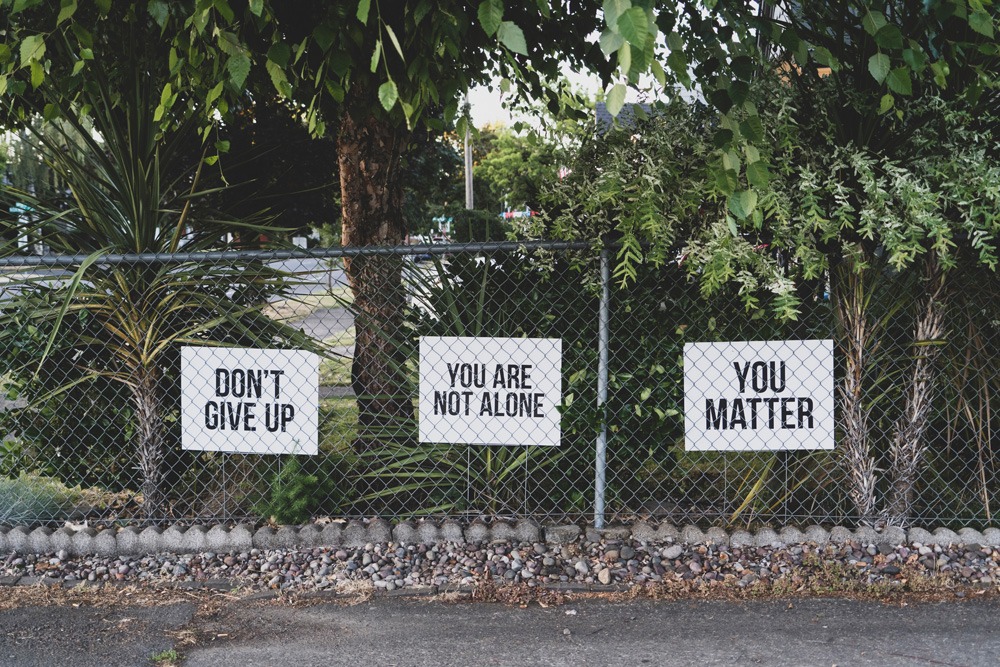Mental health crisis
How much has the number of patients with mental disorders increased over the last few decades and what does Sigmund Freud have to do with it? What needs to be changed in the approach to mental health treatment worldwide, and why do we need to act now?

We live in a society that has put their whole life on external development, that is progress in all things measurable. Buildings are getting taller, assets - bigger, technologies - newer, and living conditions - better (well, at least for some people). However, this is all for a huge price, which is the deteriorating state of our inner world.
Global statistics clearly show that people's mental health does not improve with the GDP growth. Quite the contrary! In 2017, in the United States alone, there were 47,000 suicides and 1.4 million attempted suicides. These are the highest suicide rates since World War II!
The situation in our country doesn’t look bright either. Every fourth citizen of Poland struggles with psychological issues at some stage of life (mood disorders, depression, addiction, panic attacks, etc.). [1]
These numbers are just the tip of the iceberg. There’s a lot more coming as I have a handful of quite serious statistics for you.
However, before we take a look at them, I would like us to go back 100 years or so. Let’s take a moment to understand one of the causes (in my humble opinion, one of the most critical ones) of the mental health crisis in our society.
The story of our misery
How did we find ourselves in such a difficult place?
Sigmund Freud, the father of psychoanalysis, contributed to this sort of by accident, unintendedly. That’s the man who changed the way we think about ourselves. He rejected the rationality of human behaviour, believing that our lives are governed by irrational and emotional fears and desires hidden deep in our subconscious. His concepts related to the functioning of the human mind had a great impact on the entire culture as well as the future of psychology and psychotherapy.
And although I could go on and on about Freud, today I would like to focus on his nephew Edward Bernays (born in 1891), who combined the notion of crowd psychology with the psychoanalytical ideas of his uncle, Sigmund Freud. He believed that it is necessary to manipulate the masses because people are irrational and, as a result of the herd instinct, can commit violent acts. Referred to by the media as the "father of public relations", Bernays was named as one of the 100 most influential Americans of the 20th century by Life magazine.

Bernays was the pioneer of propaganda. It was at the beginning of his career that he understood the great difference between what people need and what they want. So, he started to work with corporations and governments using techniques borrowed from Freud.
The results of this cooperation were spectacular. The story of how women began smoking comes as a good example. In the 20s of the 20th century, tobacco companies became aware of how much their profits would increase if only smoking got popular among the fairer sex (at that time, almost all American population of men smoked). The CEO of the American Tobacco Company hired Edward Bernays, who managed to eliminate social taboos related to women who smoke in public.
That was the time in history when women fought for their rights and one of their deepest desires was to gain greater freedom and social equality. Therefore, Bernays associated smoking cigarettes with "torches of freedom," equating smoking to the emancipation of women in his social campaign. He even paid women to smoke cigarettes during the Easter Sunday Parade in New York in 1929. He also hired photographers so that properly cropped photos of women released indulging in smoking were later published in newspapers around the world.
The numbers speak for themselves - in 1923, women bought only 5 percent of cigarettes sold, while in 1929 it was already 12 percent, and in 1935 the share reached 18 percent. [2]

The above example is one of Bernays' many successes. When the business world understood the power of using Freud techniques to influence the masses, corporations began to organize the so-called "focus groups" which were supposed to help them understand the deep, unconscious desires of people.
"The conscious and intelligent manipulation of the organized habits and opinions of the masses is an important element in democratic society.”
Along with his further successes, Edward Bernays became involved in cooperation with government, using his techniques to influence public opinion. In one of his projects, he made Guatemala seem as a communist threat to the American society, which allowed the overthrow of the Guatemalan government with the approval of US residents.
The refinement and propagation of public relations techniques had devastating effects on the society’s well-being. The people’s authentic needs were now completely off the radar. It echoed very clearly in the words of Paul Mazur, a leading Wall Street banker working in 1927 for Lehman Brothers: "We must shift America from a needs- to a desires-culture. People must be trained to desire, to want new things, even before the old have been entirely consumed. [...] Man's desires must overshadow his needs."[3]

The time has come when the world of politics and business ceased to be interested in supporting people in satisfying their own needs for creating artificial needs and tailoring products almost exclusively to their subconscious desires.
What are the consequences of this phenomenon for the individual? What happens in our psyche when we are constantly told what we need and what we should be doing?
Moving away from the self
The famous psychotherapist Carl Rogers characterized the mechanism of creating a false self-image. According to him, we are our authentic selves when we listen to the signals coming from our body, i.e. feelings and emotions that come as a compass, pointing out our needs to be met.
However, when someone begins to rely on somebody else’s feelings as their own, they begin to lose confidence in what their own body is telling them.
That’s how we create a false self. For example, when a teenager in love hears from her parents that her dream boyfriend is not good for her and should not hang out with him, her strong trust in her parents’ opinion will win over her self-confidence.
In this way, we stop trusting our internal compass, we lose contact with ourselves and start to rely on other people to tell us what we should feel and do.
In his book "A Way of Being", Rogers writes that with the gradual decline in confidence in our own experiences, our self-esteem deteriorates, and finally our personal experiences cease to play their natural role. [4] We stop managing our lives in accordance with our needs and begin to rely on what others think is good for us. The inevitable effect of such distancing from ourselves is a growing sense of confusion, emptiness and unhappiness.

What does it have to do with the global mental health crisis?
The enormous pace of economic development forced companies to constantly invent even better ways to influence the consumers’ psyche in order to get an edge over their competition. Teams of the most outstanding neuropsychologists and the latest brain neuroimaging technologies allow corporations to lure consumers into purchasing like with the touch of a magic wand. Commercials resemble small pieces of art that can evoke emotions like a really good Oscar-winning film.
The marketing strategies have become so sophisticated that millions of people use products that not only do not meet their needs but also harm them and hinder them in achieving serenity and satisfaction with life. Since we were very young, we have been taught to live in a society where one needs to fight for being popular, and there is no higher level of success than fame; where we are bombarded with messages about what is good for us and what our life should look like from almost every TV, computer and smartphone screen. Our mind is constantly being programmed, and that is going on even when we are well aware of it.
The influence of the business world on the psyche of the individual is certainly not the only reason for our society’s deteriorating mental well-being. However, I think that this is the most important one. It is not just about more effective ads or eye-catching leaflets.
The biggest problem is not the fact that we buy things that we don't need but the whole process of shaping entire cultures and attitudes among various social groups that has been going on for decades now. Its consequences can be seen, for example, in the consumerism and materialistic approach to life that is ubiquitous in the Western world.
For the most part, the business community’s main goal is to create and cultivate people's internal states, in which they are most prone to buying something that they don't need.
Most often these states encompass feelings and beliefs associated with deprivation, emptiness, loneliness and low self-esteem. This is why on the covers of so many magazines there are retouched faces of models always looking good. Whenever I feel ugly, bad, stupid or weak, I will do whatever I can to quench this feeling and this is when the quick solution advertised to me seems like a good idea (e.g. have you seen an ad of a shampoo that boosts confidence?).

Governments focus on GDP rather than measure society’s happiness. In the report Mismeasuring Our Lives: Why GDP Doesn't Add Up, economist Joseph Stiglitz wrote: “What we measure affects what we do: if we measure the wrong thing, we will do the wrong thing. If we focus only on material well-being – on, say, the production of goods, rather than on health, education, and the environment – we become distorted in the same way that these measures are distorted; we become more materialistic.”
When we add to this the destructive mechanisms of the education system, the lack of any psychological curriculum in schools, teaching children to deny and suppress difficult emotions, notoriously low funds for developing mental health care system, no interest of local and national authorities in the knowledge on trauma and human psyche, then what is happening in our society shouldn’t surprise us that much.
So let's take a look at the cold facts.
A handful of statistics
Before I present you with these poignant data, there is one thing I would like you to take into consideration, namely the fact that in the last century the topic of mental health was not discussed frequently or freely. Both unwanted emotions and mental disorders were taboo subjects, which is why the surveys carried out at that time are likely to have contained some margin of error.
The more recent the studies, the greater the openness of our society, and thus the sincerity of respondents in this type of surveys, which may have, to some degree, contributed to the rise in particular ratios. Nevertheless, even if such a phenomenon had actually affected these statistics in such a way, the gap between the past and the present is too significant to be neglected.
Are you ready? Brace yourself. We will start with the United States (most data available).
United States
- Just to recap what I wrote at the beginning of this article, in 2017 there were 47,000 suicides and 1.4 million suicide attempts in the US.
- The suicide rate increased by 1 percent between 2000 and 2006 and by 2 percent between 2006 and 2016.
- In 2017, there were 70,000 cases of overdose, and 17.3 million people (7 percent of the American population) had at least one episode of depression.
- The most common cause of death in the United States (among people under 50) is overdose. Every three weeks, the number of deaths from overdose equates the number of victims of 9/11 events.
- The total economic burden of drug misuse and measures adopted (including the costs of healthcare, lost productivity, addiction treatment, and criminal justice involvement) in the US alone is estimated at between 80 and 100 billion dollars a year [5].
- The number of residents of the United States killed by members of their family is higher than the number of people that this country lost in both World Wars.
- 2/3 of people suffering from mental disorders or substance dependence do not receive any treatment.
- According to a study published in the Journal of Abnormal Psychology, between 2009 and 2017, the depression rate for children aged 14-17 increased by over 60 percent. [6]
- For children aged 12 and 13, the increase was 47 percent, and for children aged 18 to 21 - 46 percent.
- Among adolescents, the rate of people who have suicidal thoughts, planning or attempting suicide has increased drastically, and in some cases doubled between 2008 and 2017.
- Half a million of children and adolescents in the United States take antipsychotics, and the number of very young (aged between 2 and 5), privately insured children using such drugs has doubled between 2000 and 2007.
United Kingdom
- In Great Britain, more than 9 million people struggle with loneliness often or on a daily basis. [7]
- The number of psychiatric drugs prescribed for depression, neurosis, obsessive compulsive disorders and panic attacks increased from 31 million in 2006 to 65 million in 2016 (e.g. by 108.5 percent). [8]
And what about Poland?
- In Poland, 4 million people (10 percent of the population) suffer from depression.
- Most of them do not seek help. On average, the time from the first symptom of depression to the first visit to the mental health specialist is 11 years.
Some statistics from around the world
- In India and China (which account for one third of the world's population), over 80 percent of people with mental problems do not seek help. [9]
- According to WHO (World Health Organization), every year almost 800,000 people commit suicide (the second leading cause of death among people between 15 and 29). This exceeds the number of people dying of malaria, breast cancer, homicides or wars. Only 38 countries adopt measures to counter the suicide epidemic.
- Since 1987, the number of people with depression have increased by 450 percent. [10] There are now over 5 times as many people using antidepressants as in 1987.
- According to WHO, men commit suicide more often than women, except for such countries as Bangladesh, China, Lesotho, Morocco and Burma. 79 percent of suicides are committed in the world’s poorest countries.
- WHO predicts that by 2030 depression will become the major health burden worldwide.
What can be done?
As we look at all these depressing data, what might shock us most is the fact that neither media nor governments have announced a global mental health crisis. If they did, it could mobilize the entire world to seek effective solutions to this issue. However, if we recall the first part of the article, their silence and neglect becomes somewhat more understandable.
Fortunately, in recent years we could see a light at the end of the tunnel as governments in some countries are starting to look more closely at the mental health situation of their citizens.
For instance, the Prime Minister of New Zealand announced a surprisingly large budget for mental health care amounting to 1.9 billion New Zealand dollars. This is the first country that has planned its budget, taking into account the priority of the well-being of its people. Moreover, in January 2018, a separate ministry was established in the United Kingdom, which aims to deal with the plague of loneliness in this country (studies show that the sense of loneliness has a more detrimental effect on our health than smoking 15 cigarettes a day).
Unfortunately, it is still merely a drop in the ocean. Below we will look at the most pressing mental health care problems and potential solutions to them.
The proposed solutions come from my subjective opinions and ideas on how we can approach the challenges described. If you notice any errors in my reasoning or see better ways to solve these issues, please share your knowledge/opinion in the comments or contact me directly.
Problem # 1
We lack effective methods of psychological treatment. The effectiveness of antidepressants leaves much to be desired as the side effects and withdrawal syndrome make the (often unavoidable) use of this type of medication very difficult. Hardly any public funds are allocated to the research on innovative therapies.
Solution # 1
More money needs to be allocated to exploring and studying of new ways of treatment.
Problem # 2
Less than half of people suffering from mental disorders receive treatment (in many countries the rate is less than 10 percent). What is it so? Lack of funds for reimbursement of treatment, lack of qualified professionals, social ostracism related to mental health problems and not sufficient education or awareness in the field of mental disorders and the availability of professional help.
Solution # 2
We need a global social campaign to make people aware of the scale of the problem and the crucial role of psychological treatment. This applies not only to the Western countries, but to poorer and developing countries in particular, as this is an even more burning issue there. We could also use a separate campaign encouraging young people to choose a career in helping people with problems of this nature (psychiatrists, psychotherapists, psychologists). In addition, we need a network of mental health treatment facilities, so that professional help is available to people living in remote areas.

Problem # 3
"Difficult" patients are often denied the treatment process, because treating them makes the statistics of the facilities look bad. This problem is most noticed and described in the United States, where one can observe how medical institutions are obsessed with results and statistics (good performance ratios allow for obtaining additional funds for the institution’s development). Treatment centres that lead in this area are usually those that focus on patients with "smaller" problems, because their treatment is easier and faster. Each cured patient improves facility’s statistics, so people whose treatment is difficult, long and costly are simply rejected. Lack of improvement after undergone treatment is often the reason for the facility to deny the patient any follow-up treatment.
Solution # 3
We need to change the way mental health facilities work from result oriented to patient oriented. The level of funding should not depend on the facility’s results, as this causes pathological situations such as rejecting patients with complicated disorders.
Problem # 4
Most of the diagnoses provided by psychiatrists are wrong. The Psychiatry Research study conducted by scientists from the University of Liverpool shows that psychiatric diagnoses are scientifically worthless as tools in identifying mental diseases. [11] It turns out that symptoms of various disorders experienced by patients overlap, and nearly all diagnoses underplay the impact of trauma.
Dr. Kate Allsopp, who was in charge of the study, said: "Although diagnostic labels create the illusion of an explanation, they are scientifically meaningless and can create stigma and prejudice." John Read was even more explicit about it: "It may be time for us to stop pretending that medical terms bring anything to our understanding of the complex, underlying causes of human mental problems and the kind of help that is needed."
It is also worth mentioning here the notorious cases when patients who are somehow labelled as “difficult” are provided with an unfair and inaccurate diagnosis of a personality disorder (most frequently borderline).[12] This usually happens when a patient, frustrated with the approach to treatment received in a mental health institution, shows their dissatisfaction. Such behaviour is quickly assessed by doctors at the facility as manipulative or indicative of a mental disorder.
Solution # 4
Let me quote again the research lead scientist Dr. Kate Allsopp: "I hope these findings will encourage mental health professionals to think beyond diagnoses and consider other explanations of mental distress, such as trauma and other adverse life experiences."
A more holistic approach to a patient would certainly be more helpful. It would require more cooperation between specialists from various fields, which would allow to gain a deeper understanding of different psychological disorders. For instance, in recent years there has been a lot of research devoted to the impact of the state of bacterial flora on our well-being. It proves that, in some cases, the gut microbiome disorder is involved in the development of depression. It is worth moving away from diagnostic labelling that narrows down both the patient’s complex condition and the scope of therapeutic results, and focusing on the individual symptoms and experiences of distress, and adjusting the forms of therapy to the individual.

Problem # 5
The next problem is treating symptoms instead of the cause of the disease. According to the well-known psychotherapist, author of many books on trauma and addictions, Gabor Mate, trauma, the etiologies of addictions and the connection between the two are not well understood by specialists from the medical, legal and political fields. Hardly any medical student would hear the word "trauma" during the 4 years of their studies. As a result of all this, we only focus on dealing with symptoms and effects, in other words, we try to control patient’s condition without understanding its cause.
Solution # 5
In recent years, it’s become clear to us that past trauma is one of the main causes of various mental disorders and diseases. Depending on various factors - the age we were when we experienced trauma, the genes we inherited or the nature of the trauma - we will experience different forms of disorders and diseases. However, it is the treatment of the trauma itself, and not only its symptoms, that should be the focus of mental health professionals. Therefore, we need to inform the society about trauma and its underlying mechanisms.
This also applies to minor trauma, which results from the accumulation of difficult experiences in the past. It is less severe but still can be a significant factor in the development of depression, addiction or other emotional problems later in life.
Problem # 6
Governments don’t fund educational projects for parents on how to raise children. In result of that, parents make mistakes that can have catastrophic consequences for the future well-being of their children. An example is the concept of leaving a crying baby alone in order to teach them to cry out. Studies show that excessive crying can cause irreversible damage to a child's brain. [13] Unfortunately, many parents are still unaware of this, just as they are unaware of the consequences of many other behaviours (e.g. spanking or verbal abuse).
The same applies to children themselves. There is no psychological education in schools. Children have no understanding of their emotions and do not know how to keep mental hygiene. In turn, teachers often are not aware of the complexity of the processes determining the development of the child's psyche.
Solution # 6
We need well thought-through and extensive training programs targeted at children, parents and teachers, as well as decision makers of the school system. Each of these groups needs to understand the underlying processes determining the development of the child's psyche, so as to build more supportive relationships with children and avoid common mistakes in the upbringing and education. Adults themselves may first need support in working out their own traumas (most of us were the object rather than the subject in education and upbringing), so that they are able to build good relationships with children. This alone will allow us to shield them from developing a huge number of disorders, which most often shape during the first years of life.

As you can see, there is a lot to be done. The good news is that at this stage we know a lot about the nature and causes of mental disorders and diseases, and we need to build and spread this awareness as soon as possible.
My main goal is creating, developing and popularizing innovative and more effective therapy methods. In recent years, so many new approaches to healing the mind have come up and some of them are very promising. One of the methods I strongly believe in (but which in Poland will undoubtedly be found controversial) will be presented in more detail in one of the following articles.
If you feel you are in a situation where you need psychological help, you don’t have to struggle on your own. Do get some help!
Feel welcome to share in the comments the feelings you have after reading this text. How do you feel about what you have learned here? What's your opinion on the subject? What else do you think can be done to overcome this crisis?
If you feel that what you have read here is important, please share this article with your friends. Thank you!
Footnotes
1. Research carried out a few years ago by the Institute of Psychiatry and Neurology in Warsaw, the Medical Academy in Wroclaw and the National Institute of Public Health - National Institute of Hygiene.
2. O'Keefe, Anne Marie; Pollay, Richard W. (1996). "Deadly Targeting of Women in Promoting Cigarettes". Journal of the American Medical Women's Association. 51 (1-2).
3. Quoted from an article published in 1927 by Paul Mazur in the Harvard Business Review.
4. C. Rogers, Manner, translated by Maciej Karpiński, REBIS, 2002
5. Data Center for Workplace Mental Health
6. Research published in the Journal of Abnormal Psychology: Link
7. Report from 2017 published by Jo Cox Commission on Loneliness
8. The National Ambulatory Medical Care Survey (NAMCS): Link
9. Lancet report published in October 2018
10. NHS Digital, Statistics for England, 2006-2016
11. Link
12. Link
13. Link
